dashboard HONDA PRELUDE 2000 (in English) User Guide
[x] Cancel search | Manufacturer: HONDA, Model Year: 2000, Model line: PRELUDE, Model: HONDA PRELUDE 2000Pages: 293, PDF Size: 3.43 MB
Page 48 of 293
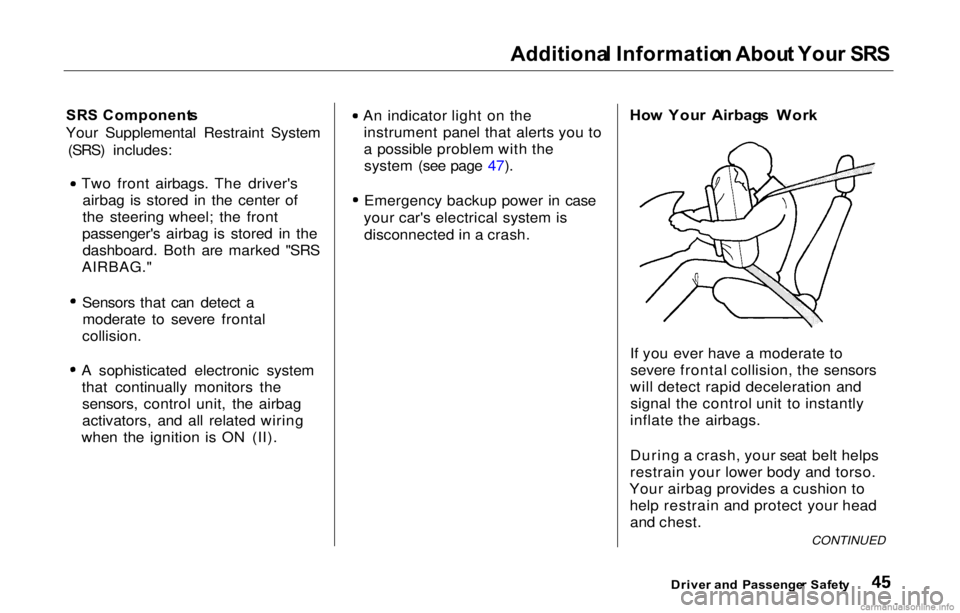
Additiona
l Informatio n Abou t You r SR S
SR S Component s
Your Supplemental Restraint System (SRS) includes: Two front airbags. The driver's
airbag is stored in the center of
the steering wheel; the front
passenger's airbag is stored in the dashboard. Both are marked "SRS
AIRBAG." Sensors that can detect a
moderate to severe frontal
collision. A sophisticated electronic system
that continually monitors thesensors, control unit, the airbag
activators, and all related wiring
when the ignition is ON (II). An indicator light on the
instrument panel that alerts you to
a possible problem with thesystem (see page 47). Emergency backup power in case
your car's electrical system is disconnected in a crash. Ho
w You r Airbag s Wor k
If you ever have a moderate to severe frontal collision, the sensors
will detect rapid deceleration and signal the control unit to instantly
inflate the airbags.
During a crash, your seat belt helps
restrain your lower body and torso.
Your airbag provides a cushion to help restrain and protect your headand chest.
Driver an d Passenge r Safet y
CONTINUED
Page 66 of 293
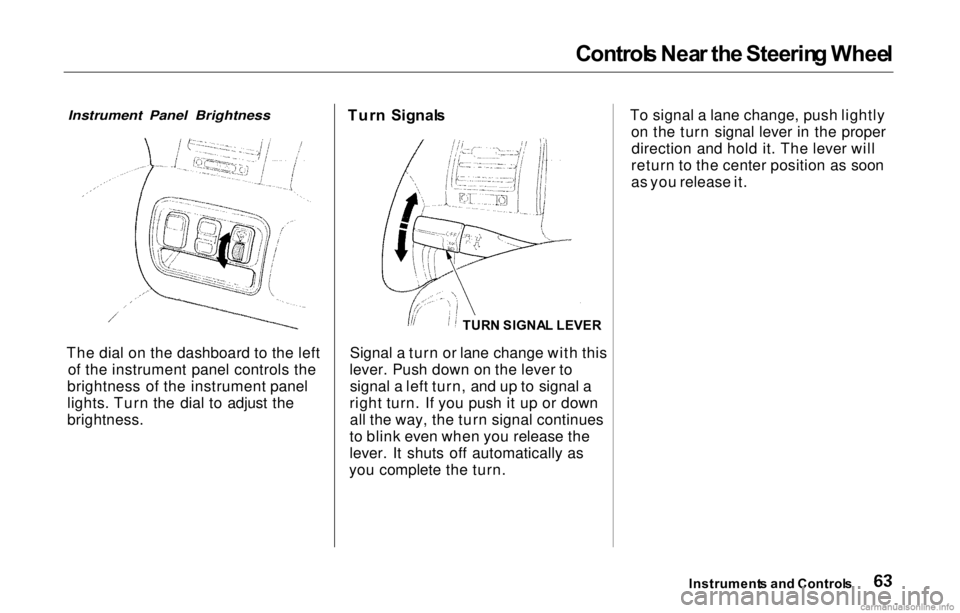
Control
s Nea r th e Steerin g Whee l
Instrument Panel Brightness
The dial on the dashboard to the left of the instrument panel controls the
brightness of the instrument panel
lights. Turn the dial to adjust the
brightness. Tur
n Signal s
Signal a turn or lane change with this
lever. Push down on the lever to signal a left turn, and up to signal a
right turn. If you push it up or down all the way, the turn signal continues
to blink even when you release the
lever. It shuts off automatically as
you complete the turn. To signal a lane change, push lightly
on the turn signal lever in the properdirection and hold it. The lever will
return to the center position as soon
as you release it.
Instrument s an d Control s
TUR
N SIGNA L LEVER
Page 90 of 293
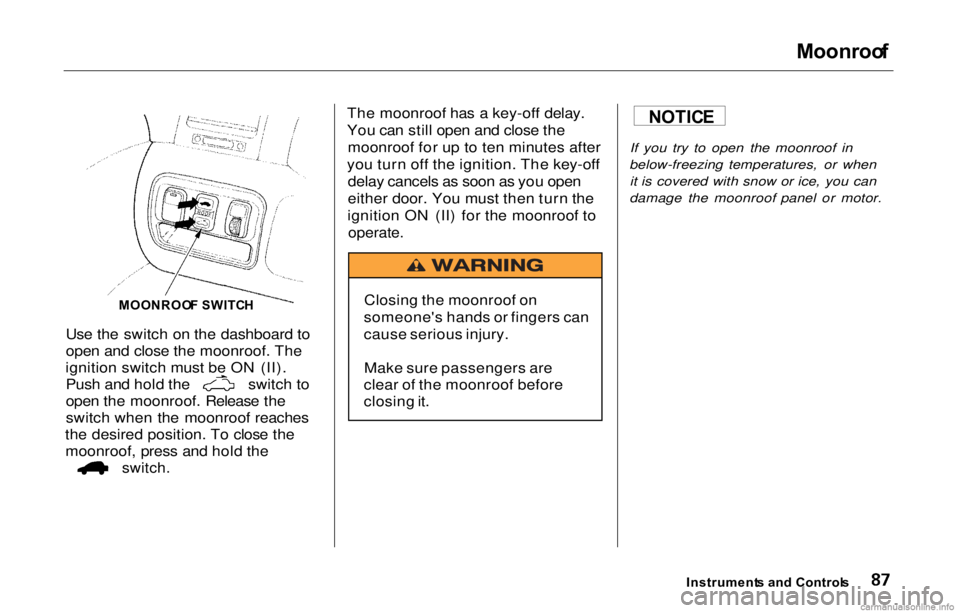
Moonroo
f
Use the switch on the dashboard to
open and close the moonroof. The
ignition switch must be ON (II). Push and hold the switch to
open the moonroof. Release the
switch when the moonroof reaches
the desired position. To close the moonroof, press and hold the
switch.
The moonroof has a key-off delay.
You can still open and close the
moonroof for up to ten minutes after
you turn off the ignition. The key-off delay cancels as soon as you open
either door. You must then turn the
ignition ON (II) for the moonroof to
operate.
If you try to open the moonroof in
below-freezing temperatures, or when it is covered with snow or ice, you can
damage the moonroof panel or motor.
Instrument s an d Control s
MOONROO
F
SWITC H
Closin
g the moonroof on
someone's hands or fingers can
cause serious injury.
Make sure passengers are
clear of the moonroof before
closing it.
NOTIC
E
Page 102 of 293
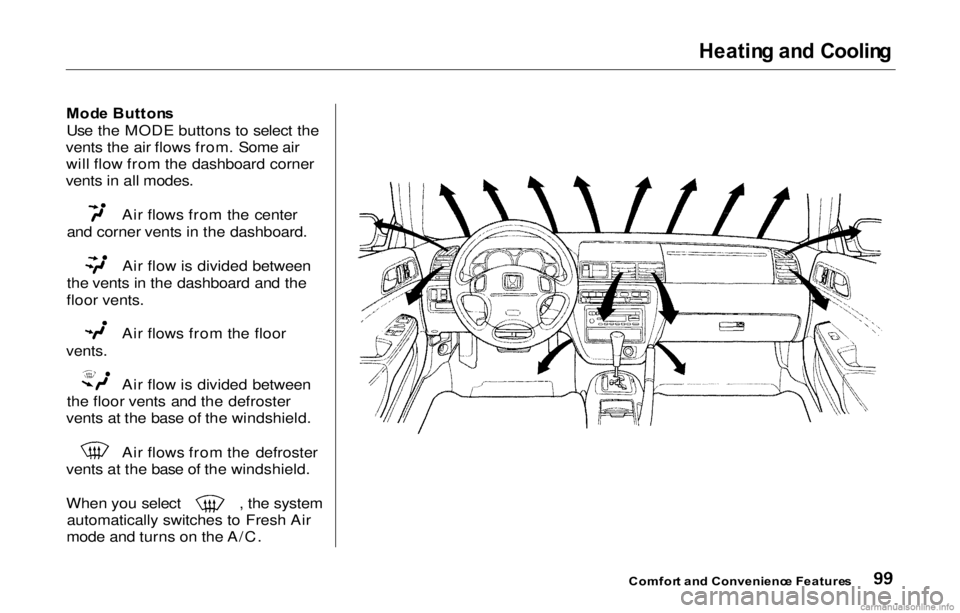
Heating an d Coolin g
Mode Button s
Use the MODE buttons to select the
vents the air flows from. Some air will flow from the dashboard corner
vents in all modes.
Air flows from the center
and corner vents in the dashboard.
Air flow is divided between
the vents in the dashboard and the
floor vents.
Air flows from the floor
vents.
Air flow is divided between
the floor vents and the defroster
vents at the base of the windshield.
Air flows from the defroster
vents at the base of the windshield.
When you select , the system automatically switches to Fresh Air
mode and turns on the A/C.
Comfor t an d Convenienc e Feature s
Page 103 of 293
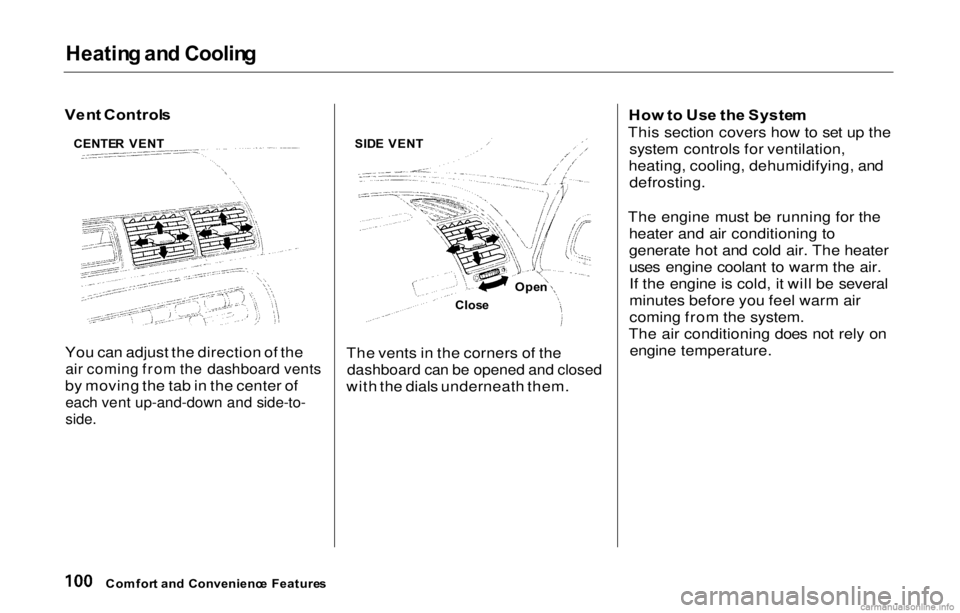
Heatin
g an d Coolin g
Ven t Control s
You can adjust the direction of the
air coming from the dashboard vents
by moving the tab in the center of
each vent up-and-down and side-to-
side.
The vents in the corners of the
dashboard can be opened and closed
with the dials underneath them. Ho
w to Us e th e Syste m
This section covers how to set up the system controls for ventilation,
heating, cooling, dehumidifying, and defrosting.
The engine must be running for the heater and air conditioning to
generate hot and cold air. The heater
uses engine coolant to warm the air.If the engine is cold, it will be several
minutes before you feel warm air
coming from the system.
The air conditioning does not rely on engine temperature.
Comfor t an d Convenienc e Feature s
CENTE
R VEN T
Open
SID
E VEN T
Close
Page 131 of 293
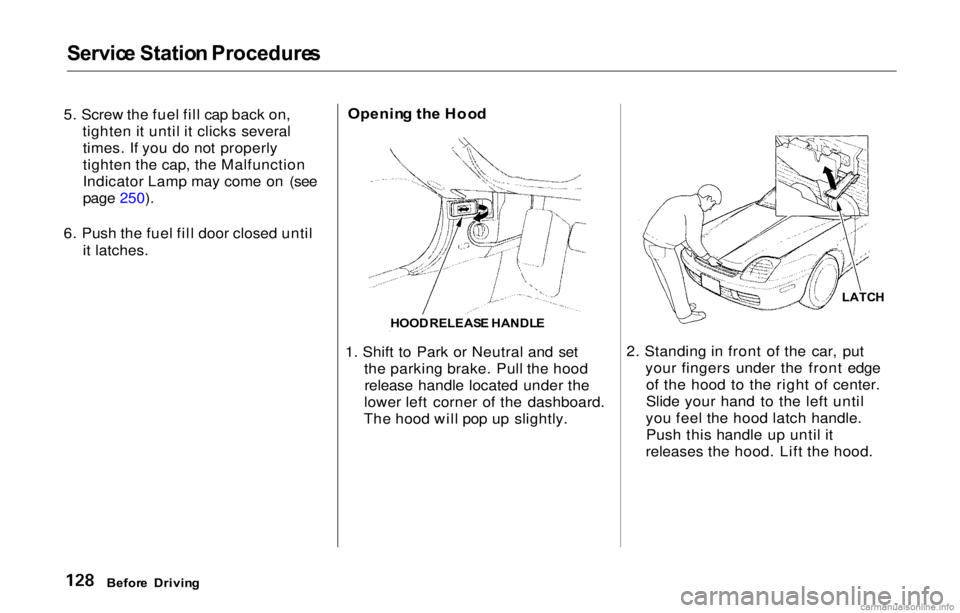
Service Statio n Procedure s
5. Screw the fuel fill cap back on,
tighten it until it clicks severaltimes. If you do not properly
tighten the cap, the Malfunction
Indicator Lamp may come on (see
page 250).
6. Push the fuel fill door closed until it latches. Openin
g th e Hoo d
1. Shift to Park or Neutral and set the parking brake. Pull the hoodrelease handle located under the
lower left corner of the dashboard.
The hood will pop up slightly. 2. Standing in front of the car, put
your fingers under the front edgeof the hood to the right of center.
Slide your hand to the left until
you feel the hood latch handle. Push this handle up until it
releases the hood. Lift the hood.
Befor e Drivin g HOOD
RELEAS E HANDL E
LATCH
Page 137 of 293

Accessorie
s an d Modification s
Modification s
Do not remove any original
equipment or modify your car in any
way that would alter its design or operation. This could make your car
unsafe and illegal to drive.
For example, do not make any
modifications that would change the
ride height of your car, or install
wheels and tires with a different overall diameter.
Such modifications can adversely
affect handling, and interfere with
the operation of the car's anti-lock brakes and other systems. In addition, any modifications that
decrease ground clearance increase
the chance of undercarriage parts striking a curb, speed bump, or other
raised object, which could cause
your airbags to deploy.
Do not modify your steering wheelor any other part of your
Supplemental Restraint System.
Modifications could make the
system ineffective. Additiona
l Safet y Precautio n
Do not attach or place objects on the
airbag covers. Any object attached to
or placed on the covers marked "SRS
AIRBAG," in the center of the steering wheel and on top of the
dashboard, could interfere with the
proper operation of the airbags. Or, if the airbags inflate, the objects
could be propelled inside the car and
hurt someone.
Befor e Drivin g
Page 256 of 293
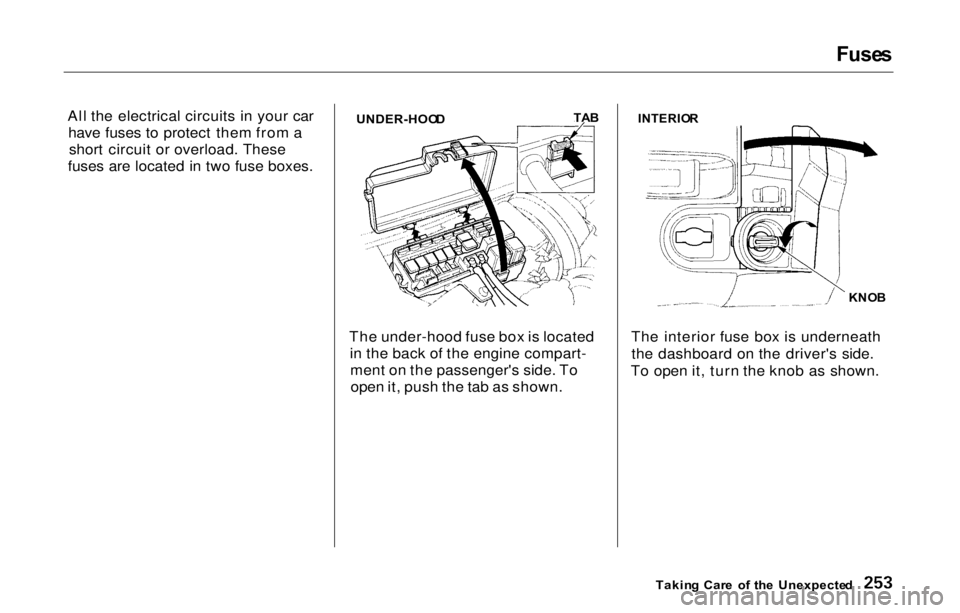
Fuse
s
All the electrical circuits in your car have fuses to protect them from ashort circuit or overload. These
fuses are located in two fuse boxes.
The under-hood fuse box is locatedin the back of the engine compart-ment on the passenger's side. Toopen it, push the tab as shown. The interior fuse box is underneath
the dashboard on the driver's side.
To open it, turn the knob as shown.
Takin g Car e o f th e Unexpecte d
UNDER-HOO
D
TA
B
INTERIO R
KNOB
Page 265 of 293
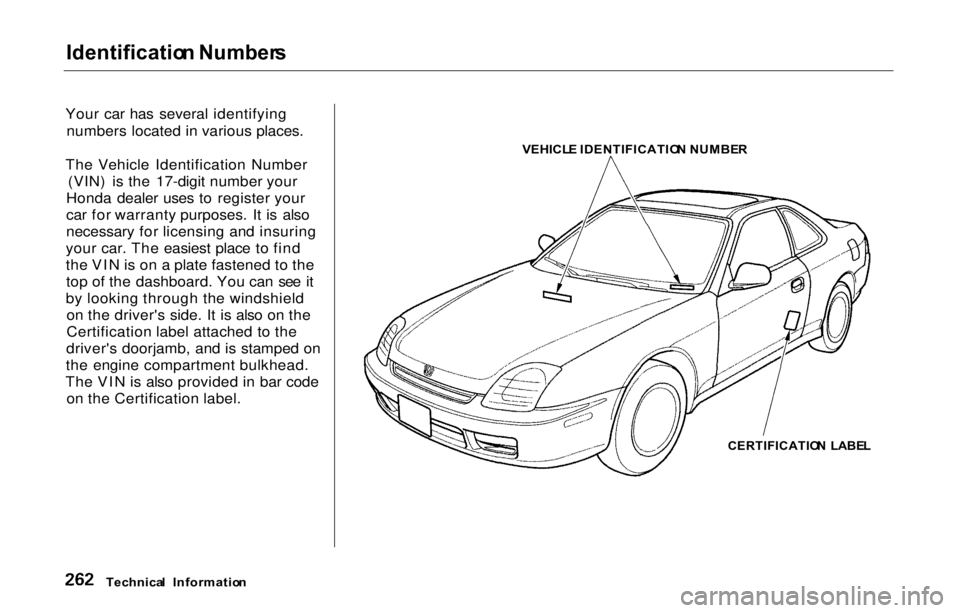
Identificatio
n Number s
Your car has several identifying numbers located in various places.
The Vehicle Identification Number (VIN) is the 17-digit number your
Honda dealer uses to register your
car for warranty purposes. It is also
necessary for licensing and insuring
your car. The easiest place to find
the VIN is on a plate fastened to the top of the dashboard. You can see it
by looking through the windshield on the driver's side. It is also on the
Certification label attached to the
driver's doorjamb, and is stamped on
the engine compartment bulkhead.
The VIN is also provided in bar code on the Certification label. VEHICL
E IDENTIFICATIO N NUMBE R
CERTIFICATIO N LABE L
Technica l Informatio n
Page 286 of 293
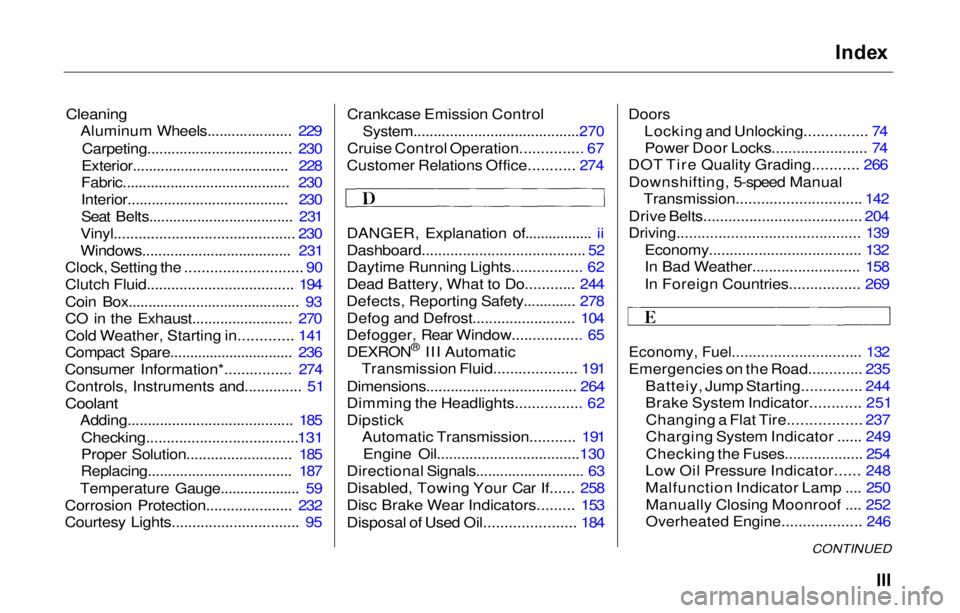
Inde
x
Cleaning
Aluminum Wheels..................... 229
Carpeting.................................... 230
Exterior....................................... 228
Fabric.......................................... 230
Interior........................................ 230
Seat Belts.................................... 23
1
Vinyl............................................ 230
Windows..................................... 231
Clock, Settin
g the ............................ 90
Clutch Fluid.................................... 194
Coin Box........................................... 93
CO in the Exhaust......................... 270
Cold Weather, Starting in.............
141
Compact Spare............................... 236
Consumer Information*................
274
Controls, Instruments and.............. 51
Coolant
Adding......................................... 185
Checking.....................................
131
Proper Solution.......................... 185
Replacing.................................... 187
Temperatur
e Gauge.................... 59
Corrosion Protection..................... 232
Courtesy Lights............................... 95 Crankcase Emission Control
System.........................................270
Cruise Control Operation............... 67
Customer Relations Office........... 274
DANGER, Explanation of.................
ii
Dashboard........................................ 52
Daytime Running Lights................
. 62
Dead Battery, What to Do............ 244
Defects, Reporting Safety............. 278 Defog and Defrost......................... 104
Defogger, Rear Window................. 65
DEXRON ®
III Automatic
Transmission Fluid.................... 19
1
Dimensions..................................... 264
Dimming the Headlights................
62
Dipstick Automatic Transmission........... 19
1
Engine Oil...................................130
Directional Signals...........................
63
Disabled, Towing Your Car If...... 258
Disc Brake Wear Indicators......... 153
Disposal of Used Oil...................... 184 Doors
Locking and Unlocking............... 7
4
Power Door Locks....................... 7
4
DOT Tire Quality Grading...........
266
Downshifting, 5-speed Manual
Transmission.............................. 14 2
Driv
e Belts...................................... 204
Driving............................................ 139
Economy..................................... 132
In Bad Weather.......................... 158
In Foreign Countries................. 269
Economy, Fuel............................... 132
Emergencies on the Road............. 235 Batteiy, Jump Starting.............. 244
Brake System Indicator............ 251Changing a Flat Tire................. 237
Charging System Indicator ...... 249
Checking the Fuses................... 254
Low Oil Pressure Indicator...... 248
Malfunction Indicator Lamp .... 250
Manually Closing Moonroof .... 252
Overheated Engine................... 246
CONTINUED